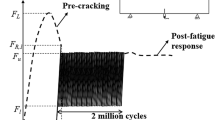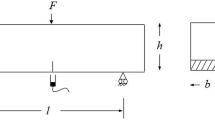Abstract
A programme of research is described that has investigated the fracture of steel fibre reinforced sprayed concrete under flexural load, with the aim of developing a stress-profile model to predict flexural behaviour in the form of a load-deflection response. This paper reports the work associated with establishing the pull-out characteristics of hooked end fibres. The effects of matrix strength, fibre embedment length and orientation are described, together with the interaction of these parameters. The relationships established can be used to model the tensile response of a beam at varying crack width and hence form a key part of the stress-profile for predicting residual flexural strength, which is an essential requirement of a much needed design rationale for steel fibre concrete.
Résumé
Le programme de recherche décrit porte sur la rupture du béton projeté renforcé de fibres d'acier sous charge en flexion. Il a pour objectif de développer un modèle de profil de contrainte capable de prévoir le comportement en flexion sous la forme d'une réponse charge-déflexion. Cet article présente un travail lié à l'établissement des caractéristiques d'arrachement de fibres aux extrémités crochetées. Les effets de la résistance de la matrice, de la longueur d'enfoncement et l'orientation des fibres sont décrits, ainsi que l'interaction de ces paramètres. Les relations établies peuvent être utilisées pour modéliser la réponse en tension d'une poutre à une largeur de fissuration variable, et donc pour former la majeure partie du profil de contrainte visant à prévoir la résistance à la flexion résiduelle, qui est l'une des exigences essentielles d'une argumentation très attendue sur l'étude des bétons renforcés de fibres.
Similar content being viewed by others
References
Robins, P. J., Austin, S. A., Chandler, J. and Jones, P. A., ‘Flexural strain and crack width measurement of steel fibre reinforced concrete by optical grid and electrical gauge methods’,Cement and Concrete Research 31 (2001) 719–729.
Robins, P. J., Austin, S. A. and Jones, P. A., ‘Spatial distribution of steel fibres in sprayed and cast concrete’, submitted toMagazine of Concrete Research (2001).
RILEM TC162-TDF: Test and design methods for steel fibre reinforced concrete, ‘σ-ε-Design method’,Mater. Struct. 33 (2000) 75–81.
Li, V. C. and Maalej, M., ‘Toughening in cement based composites. Part I: Cement, mortar and concrete’,Cement & Concrete Composites 18 (1996) 223–237.
Li, V. C. and Maalej, M., ‘Toughening in cement based composites. Part II: Fiber reinforced cementitious composites’,Cement & Concrete Composites 18 (1996) 239–249.
Balaguru, P. N. and Shah, S. P., ‘Fiber-Reinforced Cement Composites’, (McGraw-Hill, New York, 1992).
Hannant, D. J., ‘Fibre Cements and Fibre Composites’, (J. Wiley & Sons Ltd., Chichester, England 1978).
Banthia, N., ‘A study of some factors affecting the fiber-matrix bond in steel fiber reinforced concrete’,Canadian Journal of Civil Engineering 17 (1990) 610–620.
Gray, R. J. and Johnston, C. D., ‘The measurement of fibrematrix interfacial bond strength in steel fibre-reinforced cementitious composites’ in ‘Testing and Test Methods of Fibre Cement Composites’, Proceedings of the RILEM Symposium 1978, Swamy, R. N. (ed.) (The Construction Press, Lancaster 1978) 317–327.
Bartos, P. J. M., ‘Bond in fibre reinforced cement and concretes’,The International Journal of Cement Composites 3 (3) (1981) 159–177.
Giaccio, G. and Zerbino, R., Discussion of paper ‘Bond-slip mechanisms of steel fibre concrete’ by Naaman, A. E., and Najm, H. (1991),ACI Materials Journal 89 (1), (1992) 108–109.
Maage, M., ‘Fibre bond and friction in cement and concrete’ in ‘Testing and Test Methods of Fibre Cement Composites’, Proceedings of the RILEM Symposium 1978, Swamy, R. N. (ed.), (The Construction Press, Lancaster, 1978) 329–336.
Banthia, N. and Trottier, J. F., ‘Concrete reinforced with deformed steel fibres. Part I: Bond-slip mechanisms’,ACI Materials Journal 91 (5) (1994) 435–446.
Bartos, P. J. M. and Duris, M., ‘Inclined tensile strength of steel fibres in a cement-based composite’,Composites 25 (10) (1994) 945–952.
Maage, M., ‘Interaction between steel fibers and cement based matrices’,Mater. Struct. 10 (59) (1977) 297–301.
Naaman, A. E. and Shah, S. P., ‘Bond studies on orientated and aligned steel fibres’ in ‘Fibre Reinforced Cement and Concrete’, Proceedings of the RILEM Symposium 1975 (Construction Press Ltd., Lancaster, 1975) 171–178.
Naaman, A. E. and Najm, H., ‘Bond-slip of steel fibers in concrete’,ACI Materials Journal 88 (2) (1991) 135–145.
Narayanan, R. and Kareen-Palanjian, A. S., ‘Factors influencing the strength of steel fibre reinforced concrete’, in ‘Developments in Fibre Reinforced Cement and Concrete’, Volume 1, Proceedings of the Third International RILEM Symposium, 1986, Swamy, R. N.et al. (eds.), Paper 3.1
Hughes, B. P. and Fattuhi, N. I., ‘Fibre bond strengths in cement and concrete’,Magazine of Concrete Research 27 (92) (1975) 161–167.
Maage, M., ‘Interaction between steel fibers and cement based matrices’,Mater. Struct. 10 (59) (1977) 297–301.
Naaman, A. E. and Shah, S. P., ‘Pull-out mechanism in steel fiber-reinforced concrete’,Journal of the Structural Division ASCE 102 (August 1976) 1537–1548.
Mandel, J. A., Wei, S. and Said, S., ‘Studies of the properties of the fiber-matrix interface in steel fiber reinforced mortar’,ACI Materials Journal 84 (March–April 1987) 101–109.
Chanvillard, G. and Aitcin, P.-C., On the modelling of the pull-out behaviour of steel fibres’; ‘High performance fiber reinforced cement composites’, edited by H. W. Reinhardt and A. E. Naaman, in ‘Fibre Reinforced Cement and Concrete’, Proceedings of the RILEM Symposium, London, 1992, (E & FN Spon, London, 1992) 467–478.
Chanvillard, G., ‘Energy dissipation during steel fibre pull-out’, edited by Swamy, R. N., in ‘Fibre Reinforced Cement and Concrete’, Proceedings of the RILEM Symposium, London, 1992 (E & FN Spon, London, 1992) 380–389.
Alwan, J. M., Naaman, A. E. and Guerrero, P., ‘Effect of mechanical clamping on the pull-out response of hooked steel fibres embedded in cementitious matrices’,Concrete Science and Engineering 1 (3) (1999) 15–25.
Pompo, A., Stupak, P. R., Nicolais, L. and Marchese, B., ‘Analysis of steel fibre pull-out from a cement matrix using video photography’,Cement & Concrete Composites 18 (1996) 3–8.
BS 12 (1991) Specification for Portland Cements, British Standards Institution, Milton Keynes.
BS 882 (1992) Aggregates from Natural Sources for Concrete, British Standards Institution, Milton Keynes.
BS 1881: Part 111 (1983) Method for Normal Curing of Test Specimens (20°C method), British Standards Institution, Milton Keynes.
Krenchel, H., ‘Fibre spacing and specific fibre surface’, in ‘Testing and Test Methods of Fibre Cement Composites’, Proceedings of the RILEM Symposium, 1978 (Construction Press Ltd., Lancaster 1978) 69–79.
Author information
Authors and Affiliations
Rights and permissions
About this article
Cite this article
Robins, P., Austin, S. & Jones, P. Pull-out behaviour of hooked steel fibres. Mat. Struct. 35, 434–442 (2002). https://doi.org/10.1007/BF02483148
Received:
Accepted:
Issue Date:
DOI: https://doi.org/10.1007/BF02483148




